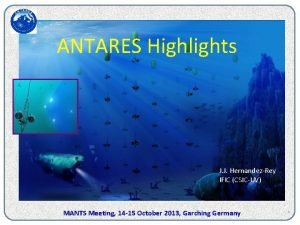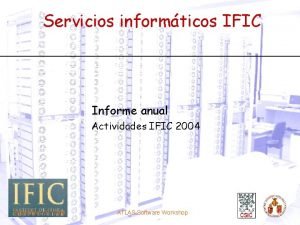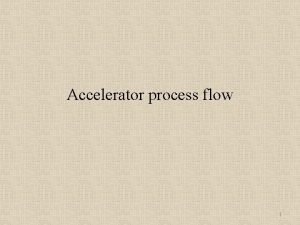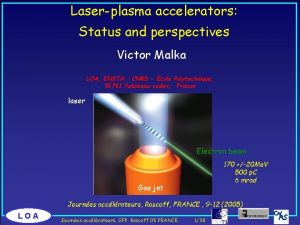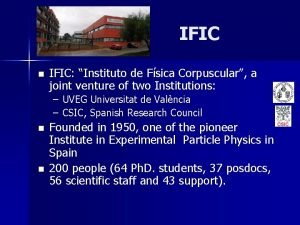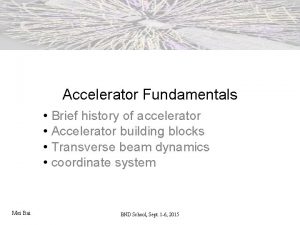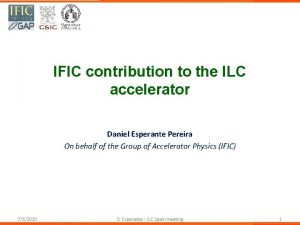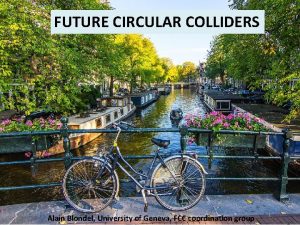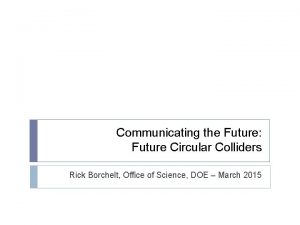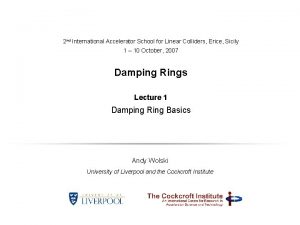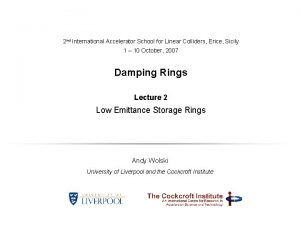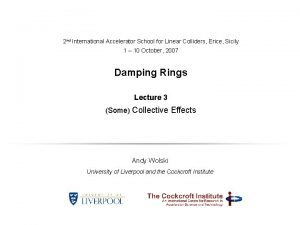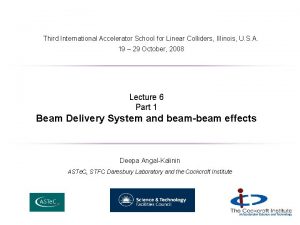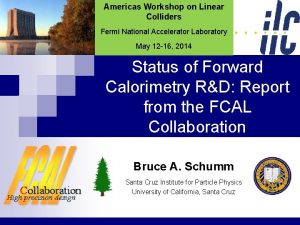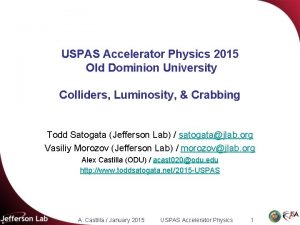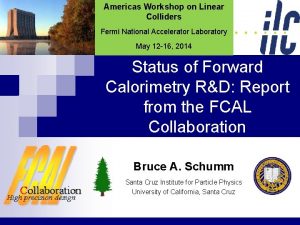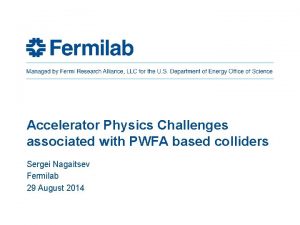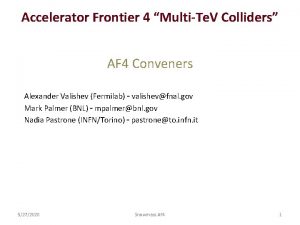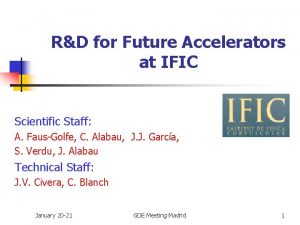Accelerator RD for Future Large Colliders at IFIC



















- Slides: 19

Accelerator R&D for Future Large Colliders at IFIC Scientific Staff: A. Faus-Golfe, C. Alabau, J. J. García, S. Verdu, J. Alabau Technical Staff: J. V. Civera, C. Blanch ILC Spain 09 1

Capabilities BEAM INSTRUMENTATION : - CALCULATION ØElectromagnetic analysis • Electric circuits & electronics ØMechanical analysis BEAM DYNAMICS EXPERTISE: ØOptics design ØNon-linear dynamics studies ØNew instrumentation techniques ØCommissioning - PROTOTYPING Emittance simulations and measuremts in ATF ØDesign: tooling, drawings ØFabrication follow-up ØAssembly ØTesting and Calibration 3 -D modelling of BPM ILC Spain 09 2

Main ongoing projects ØILC and its Test Facility ATF-ATF 2: Beam dynamic studies and commissioning of the ATF EXT line (LAL, KEK, SLAC) Multi-OTR system for ATF 2 (SLAC, KEK) BPM supports with micromovers for FONT 4 in (KEK, JAI) BDS instrumentation studies ØCLIC and its Test Facility CTF 3: BPM’s for the TBL in CTF 3 (UPC, CERN, Applied Physics-UV) Drive Beam BPM’s for CLIC module (CERN) ØSuper Large Hadron Collider: Beam dynamics studies and measurements on beam halo, intensity reach and collimation efficiency (CERN-EUCARD) ILC Spain 09 3

ILC and its Test Facility ATF/ATF 2: ATF was built in KEK (Japan) to create small emittance beams. The Damping Ring of ATF has a world record of the normalized emittance of 3 x 10 -8 m rad at 1. 3 Ge. V. ATF 2 has been built to study the feasibility of focusing the beam into a nanometer spot (~40 nm) and nanometer stability in a future linear collider. Extraction line drives the beam from ATF to ATF 2 ILC Spain 09 4

ATF and ATF 2: Emittance growth diagnostic section The beam passes horizontally off-axis through the shared magnets with the DR extraction wire scanners (OTR) OTR monitor Since several years, the vertical emittance measured in the diagnostic section of the EXT line is significantly larger than the emittance measured in the DR. The simulations and the measurements of the effect of nonlinear magnetic fields (mainly QM 7 R) show an emittance growth with a strong dependence with the extraction position. But still there must be another source for the emittance growth since the extracted beam was significantly larger than expected in three of the data sets. Recently, the QM 7 R magnet was replaced by a similar one with larger aperture, for which magnetic measurements and simulations indicate that non-linear fields are negligible at the extraction position. ILC Spain 09 Beam size at the OTR/XSR 5

ATF and ATF 2: Multi-OTR System diagnostic section wire scanners extraction (OTR) OTR monitor Emittance measurements with the wire scanners located in the diagnostic section of the EXT line are very slow. Multi-OTR (4 units) beam dynamics studies, design, construction, and characterization including associated software control and electronics ILC Spain 09 6

OTR 4 OTR 3 OTR 0 OTR 1 OTR 2 extraction OTR 1 X ATF and ATF 2: Multi-OTR System diagnostic section The location of the OTR’s has to be optimized such that the phase advances be apropiate to allow emittance measurements ILC Spain 09 7

ATF and ATF 2: Multi-OTR System Beam dynamics calculated with MAD to study the beam sizes in order to place the OTR’s. y vs x x’ vs x y’ vs y MW 0 X MW 1 X ILC Spain 09 8 8

ATF and ATF 2: Multi-OTR System The current OTR was updated with a new target and target actuator, calibrated and tested with beam during November ´ 09. CCD camera beam target Current OTR installed in the ATF 2 EXT line Beam spot measurement with OTR ILC Spain 09 9 9

ATF and ATF 2: Multi-OTR System New design of the OTR for ATF-ATF 2 New OTRs will have same controls and motion capabilities as current OTR with the following improvements: - Target actuator relocated to the top (no interference with the girder) and smaller design greater flexibility in the OTR placement Target inserter 90 deg mirror - Thinner target reduce radiation damage Prosilica camera Focus adjuster slide Mitutoyo 10 X lens And 1 x tube lens X and Y target position viewing adjusters - CCD camera parallel to the target (before it was not parallel, which meant that the beam spot was in focus on only a small portion of the target) greater depth of field. - 12 bit camera for more dynamic range with smaller pixel size for more resolution. Newport Vertical mover Installation planned on March´ 10 Newport Horizontal mover ILC Spain 09 10 10

ATF and ATF 2: BPM’s supports with micromovers for FONT 4 FONT – Feedback On Nanosecond Timescales IP intra-train feedback system • • • Last line of defence against relative beam misalignment Measure vertical position of outgoing beam and hence beam-beam kick angle Use fast amplifier and kicker to correct vertical position of beam incoming to IR ILC Spain 09 11

ATF and ATF 2: BPM’s supports with micromovers for FONT 4 design, construction, and characterization including associated electronics and software development of 3 sets Labview Software development Movers & holding structure Realignment of BPM to increase the resolution Range: ± 1 mm Step size: 10 μm Stability better than 1 μm Time response ~ sec ILC Spain 09 12

ATF and ATF 2: BPM’s supports with micromovers for FONT 4 One set has been assembled and installed in ATF 2. At the moment it’s under modification by magnetic problems. Other two sets in construction. Software already finished. Realistic simulations of the beam dynamics including the FONT feedback system are being made at the moment. Mover installed at ATF 2 ILC Spain 09 13

The CLIC and its Test Facility CTF 3: The TBL is designed to study and validate the drive beam stability during deceleration in CTF 3. The TBL consists of a series of FODO lattice cells and a diagnostic section at the beginning and end of the line. Each cell is comprised of a quadrupole, a BPM (labeled as BPS) and a Power Extraction and Transfer Structure (PETS). 3 D View of a TBL cell with the PETS tanks, the BPS’s and the quadrupoles BPS Prototype Inductive Pick-up (IPU) 2. 25 cm Inductive sensors PCB ILC Spain 09 TBL beam time structure 14

CTF 3: BPM’s for the Test Beam Line BPS Prototypes, Series Production and Calibration § A set of two prototypes of the BPS's labeled as BPS 1 and BPS 2 with its associated electronics has been designed, constructed and characterized by the IFIC team with the collaboration of the CTF 3 team at CERN (May 2008). § BPS 1, jointly with its support and its amplifier, was installed successfully at TBL; BPS 2 remained at IFIC as spare (July 2008). § BPS 1 first beam measurements were carried out (August 2008). § The BPS series production (15 units) started at IFIC labs (November 2008). § A new wire test bench for BPS series characterization tests was designed and built at IFIC (March 2009). Control and DAQ equipment for all the setup signals Low-frequency wire set-up Wire set-up for BPS prototype characterization tests at CERN Labs 3 D view design Measurements of the BPS 1 with beam in the TBL line Overview of the new wire test bench for BPS series characterization tests at IFIC labs ILC Spain 09 BPS 1 and its support installed in the TBL line 15

CTF 3: BPM’s for the Test Beam Line BPS Prototypes, Series Production and Calibration § Tests for BPS 2 and BPS 3 carried out with the new wire setup at IFIC. Less than 50 um accuracy (March 2009). §Two more BPS units was delivered and installed, BPS 2 and BPS 3 both with new improved electronic PCBs (May 2009). § 14 BPS units construction and assembly process finished (August 2009). § A Lab. VIEW application (Sens. AT v 1. 0) is developed for automatize the BPS series characterization tests in the new wire test bench (September 2009). § The 14 BPS units tests finishes, they are delivered to CERN and finally installed in TBL (October 2009). § All the BPS are validated successfully in TBL after first calibration tests (October 2009). §Beam tests in TBL for the full installed BPS series. Measurements at high beam current (30 A) and checking of the BPS’ resolution and performances. All BPS units jointly with its supports and amplifiers installed in TBL (CLEX area, CERN). ILC Spain 09 16 Calibration test in TBL shows good BPS performance with flat-top pulse response.

CTF 3: BPM’s for the Test Beam Line BPS High Frequency Test -40 d. B • To determine the BPS longitudinal coupling impedance at more than 12 GHz, affecting beam stability. • Development of HF set-up has been carried out in parallel of the BPS series production. • Electromagnetic simulation of HF setup design (until 30 GHz) with specialized software FEST 3 D • HF set-up manufacturing and BPS HF tests to be performed next January Simulation SW: FEST 3 D -40 d. B Simulation SW: HFSS Simulation results of last HF set-up design. S 11 reflection parameter from 0 to 30 GHz. 3 D views of the High frequency set-up design ILC for measuring the BPS longitudinal coupling impedance Spain 09 17

CLIC: Drive Beam BPM for the 1 st CLIC module The drive beam quadrupole and BPM are mounted on the drive beam girders. BPMs cannot be moved independently of the PETS, the quadrupoles will either be on movers, or equipped with dipole corrector coils. The BPMs are mounted before quadrupoles. The acceptable level of wake field needs to be determined. Nominal beam parameters: Charges/bunch: 10 5. 2 10 Nb of Bunches: 2922 Bunch length: 1 mm Train length: 243. 7 ns DB BPM Accuracy BPM 20µm Resolution Stability Range Bandwidth 2µm ? <5 mm 35 MHz Beam tube aperture 23 mm Available length 104/74 mm Machine Intercepting How Used in RT protection Comments device? many? Feedback? Item? No 41480 Yes Ref Inductive ? CLIC note 764 Strip line ? 18

Thanks for your Attention ILC Spain 09 19
 Future perfect future continuous exercises
Future perfect future continuous exercises Future perfect continuous and simple
Future perfect continuous and simple Br ific
Br ific Horde ific
Horde ific Itu br ific
Itu br ific 1 2 3 kondicional u engleskom jeziku
1 2 3 kondicional u engleskom jeziku Future perfect and future continuous examples
Future perfect and future continuous examples Past continuous diagram
Past continuous diagram Future nurse programme
Future nurse programme Future plans and finished future actions
Future plans and finished future actions Future perfect presentation
Future perfect presentation Present continuous tense for future use
Present continuous tense for future use Future perfect x
Future perfect x Present and past tense
Present and past tense Present continuous tense future plan
Present continuous tense future plan Growth accelerator coach
Growth accelerator coach Coherent accelerator processor interface
Coherent accelerator processor interface Fiscal policy definition
Fiscal policy definition Backup process flow
Backup process flow Loa accelerator
Loa accelerator


